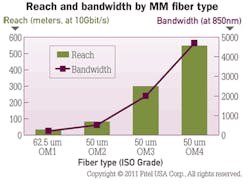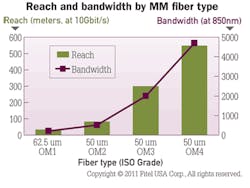Fundamental fiber choices for enterprise networks
Once you decide to go with optical fiber, you still have several decisions to make.
by Steve Cardone, OFS
These days if you are selecting the transmission medium for an enterprise network of any size, chances are you're looking at optical fiber. For use in local area networks (LANs), data centers and similar applications, fiber offers a number of important advantages compared to copper. First, it has much greater bandwidth to help you meet the demands of busy data communications networks–today and into the future. In fact, for distances greater than 100 meters at 10-Gbits/sec, or greater than a mere 7 meters at 40- and 100-Gbits/sec, optical fiber is the only medium recognized by IEEE for these applications.
Not only can fiber transmit higher data rates over longer distances, optical links also consume significantly less power than copper links, which is an important criterion in today's "green" environment. And fiber is immune to electromagnetic interference and radio-frequency interference (EMI/RFI) signals that can plague copper networks.
The highest-performing multimode fibers, OM3 and OM4, are recognized in the current draft of the TIA-942-A standard for data center infrastructure. The current draft recommends OM4 for use in these environments.
But opting for optics is only the first step. You're now faced with an increasingly complex set of decisions in your quest for the best network for your needs. Singlemode fiber, or multimode? OM2, OM3 or OM4? Standard or bend-insensitive? This article will take you through these fundamental decisions on your way to an optimized network.
Multimode balances performance, cost
Your first choice will be between the two main categories of fiber–singlemode and multimode. They are so named because of the way the light is carried in the fiber. Because of their small core size (<10 µm), singlemode fibers transmit light along a single path, or "mode." Multimode fibers have larger cores (50 µm or greater) that guide many modes simultaneously.
Singlemode fiber has advantages in terms of bandwidth and reach for longer distances (>1 kilometer at 1 Gbit/sec). It is generally designed for systems of moderate to long distance, such as broadband/FTTx, metro, access and long-haul networks. However, its tiny core requires precision alignment to inject light from the transceiver into the core, significantly driving up transceiver costs. Singlemode connections require more care, skill and precision to terminate, whether in the field or at the factory, adding cost to a singlemode system. Singlemode transceivers also consume more power than their multimode counterparts–an important consideration in operational costs.
Multimode fiber, on the other hand, easily supports most distances required for premises and enterprise networks. In fact, it can support transmission up to 550 meters at 10 Gbits/sec for long backbone and short campus runs, and up to 150 meters at 40 and 100 Gbits/sec for longer data center runs. Furthermore, the optoelectronics used with multimode fiber are generally less expensive than those required for a singlemode system. And multimode fiber is easier to install and terminate in the field–an important consideration in enterprise environments with frequent moves, adds and changes.
50- or 62.5-µm fibers?
Assuming you've opted for multimode fiber, your next decision will again be between two main product categories. The two types of multimode fiber for enterprise networks are identified by their core diameter–50 µm and 62.5 µm. While both have had their time in the sun as the preferred choice based on the standards of the day, changing market conditions have driven the re-establishment of 50-µm fiber as a better solution for applications operating at 850 nm, which is the preferred operating wavelength of today's laser-based enterprise networks.
As data rates hit 1 Gbit/sec and 10 Gbits/sec, it became apparent that 62.5-µm fiber had reached its performance limit, owing to its lower bandwidth and 850 nm. By comparison, 50-µm fiber could offer as much as 10 times the bandwidth of the 62.5-µm option, enabling robust support of 1- and 10-Gbit/sec applications. And because 1- and 10-Gbit/sec transmission use small-spot lasers, issues about power coupling into 50-µm fiber disappeared.
The IEEE 1-Gigabit Ethernet standard published in 1998 uses low-cost 850-nm vertical-cavity surface-emitting lasers (VCSELs) that can reach 1,000 meters over 50-µm fiber, compared to 220 to 275 meters on standard 62.5-µm fiber. The 10-Gbit/sec Ethernet standard, published in 2002, takes advantage of higher-bandwidth 50-µm fiber that can support 550 meters using 850-nm VCSELs, compared to 26 to 33 meters on conventional 62.5-µm fiber.
In addition, 50-µm fiber uses the same connectors, installation techniques and optoelectronics as 62.5-µm fiber. All of this, coupled with the fact that greatly improved cabling materials and processes have made 50-µm fiber cable-friendly, is driving the migration to 50-µm as the multimode fiber of choice in LANs, storage area networks (SANs), data center interconnects and now, short-distance access applications.
Differences between OM2, 3 and 4
There are several types of 50-µm multimode fiber from which to choose. They are identified in the ISO/IEC 11801 international cabling standard as "OM" fibers, which stands for "optical multimode." OM fibers available today fall into several categories.
- OM1, for fiber with 200/500 MHz.km overfilled launch (OFL) bandwidth at 850/1300 nm (typically 62.5-µm fiber)
- OM2, for fiber with 500/500 MHz.km overfilled launch (OFL) bandwidth at 850/1300 nm (typically 50-µm fiber)
- OM3, for laser-optimized 50-µm fiber having 2000 MHz.km effective modal bandwidth (laser bandwidth), designed for 10-Gbit/sec transmission.
- OM4, for laser-optimized 50-µm fiber having 4700 MHz.km effective modal bandwidth, designed for 10-, 40- and 100-Gbit/sec transmission.
OM4 is especially well suited for shorter-reach data center and high-performance computing (HPC) applications, where optical loss budgets are getting tighter and tighter as speeds reach 10 Gbits/sec and beyond to 40 and 100 Gbits/sec. The high bandwidth provided by OM4 fiber when deployed at less than its rated distance offers extra "headroom" for channel insertion loss. OM4 is also backward-compatible with applications calling for OFL bandwidth of at least 500 MHz.km at 1300 nm (e.g. FDDI, IEEE 100Base-FX, 1000Base-LX, 10GBase-LX4 and 10GBase-LRM). OM4 fiber is the "recommended" fiber in the latest draft of TIA-942-A, the first revision of the Telecommunications Infrastructure Standard for Data Centers. OM3 fiber is recognized in the draft as an accepted media type, but OM1 and OM2 fibers are no longer recognized.
Measuring multimode bandwidth
Let's assume that, based on the information above, you've selected a 50-µm OM3 multimode fiber for your network. As mentioned, this fiber should provide an EMB of 2000 MHz.km. How will you know if it delivers the promised bandwidth?
Multimode fiber bandwidth is certified by manufacturers according to one of two industry-accepted methods: the DMD mask method and the calculated effective modal bandwidth (EMBc) method. Both rely on a measurement called differential mode delay (DMD), which measures and compares the arrival time of all the modes of light in a fiber. DMD is currently the only method that checks all modes across the fiber core independently, and therefore the reliable method for verifying bandwidth required for 10-Gbit/sec performance or more. TIA/EIA and ISO/IEC have both published standards for DMD measurement and DMD specifications for laser-optimized multimode fiber.
The DMD mask method directly compares DMD test results against a set of specifications (called templates or masks) to see if the fiber has the necessary performance. This is a straightforward graphical approach to make sure the data pulses do not spread excessively beyond the required 10-Gbit/sec bit period. If the OM3 fiber in our example passes these DMD specs, then it should provide at least 2000 MHz.km EMB, no matter which standards-compliant VCSEL you use.
By comparison, the EMBc method takes the DMD results and matches them against a set of theoretical weighting functions. These weighting functions, of which there are 10, are intended to represent the launch distributions of all compliant VCSELs. The DMD results are combined mathematically with each of the 10 weighting functions. This produces 10 different EMBc values, the minimum of which is called minEMBc. The minEMBc value is then multiplied by a factor of 1.13 to obtain the fiber's EMB value. If this EMB value is ≥2000 MHz.km, the fiber is deemed compliant and should support 10 Gbits/sec at 300 meters.
Because of all the complex calculations required by the EMBc method, and the fact that the weighting functions only represent a sampling of the launch characteristics of the many VCSELs that could actually be used in a real system, the EMBc method does not provide the degree of scrutiny over fiber quality and performance that the DMD mask technique does.
Furthermore, the EMBc method virtually ignores the center 0-5 µm (radial) region of a fiber's core because the weighting functions put little emphasis on this region. This can be misleading, because excess power can be introduced into a fiber's center region from a hot-center-launch VCSEL, or from VCSELs that have been coupled off-center to the fiber. For this reason, we recommend that you specify a fiber that has good control of DMD all the way to the very center of the fiber.
Bend-insensitive's place?
Bend-insensitive multimode fibers (BIMMFs), first introduced in 2009, were developed to mitigate link failures when optical cables undergo small-diameter bends, particularly in jumper applications in data centers. There are several concerns about the use of these fibers in enterprise networks.
First, any benefit is limited to the patch field and cable routing within cabinets and enclosures. Second, there are many technical issues with BIMMF that need to be resolved in standards bodies. For example, fiber manufacturers have altered the multimode core, or "waveguide," of these fibers to improve their macrobend performance. Making changes to the waveguide impacts many other fiber properties, which then must be optimized. All BIMMF use a different profile design compared to the graded-index profile that has been used in standard multimode fiber for more than 30 years. This causes BIMMF to behave differently in systems. All BIMMF guide more mores, which can reduce system bandwidth if not properly controlled. BIMMF can also increase connection loss when mated to standard multimode fiber.
The additional modes traveling in BIMMF are of particular concern; the major reason that the industry moved from 62.5-µm fiber to a 50-µm core was to reduce the number of guided modes, allowing higher bandwidth. Because high bandwidth is the primary concern in today's high-speed systems, proper characterization of system performance is critical to ensure that BIMMF can support today's and tomorrow's demanding requirements. Standards groups are currently investigating technical issues surrounding these new fibers. Until these issues are resolved and technical requirements are agreed upon, caution should be taken in the deployment of BIMMF fiber.
Steve Cardone is marketing manager with OFS (www.ofsoptics.com).
Past CIM Issues

